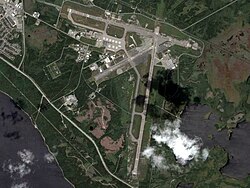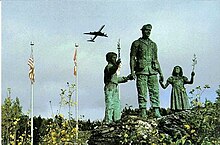Gander International Airport
| Gander International Airport | |
|---|---|

|
|
| Characteristics | |
| ICAO code | CYQX |
| IATA code | YQX |
| Coordinates | |
| Height above MSL | 151 m (495 ft ) |
| Transport links | |
| Distance from the city center | 2 km southeast of Gander |
| Street | Trans-Canada Highway |
| Basic data | |
| opening | 1938 |
| operator | Gander Airport Authority |
| Passengers | 163,668 (2016) |
| Air freight | 552 t (2016) |
| Flight movements |
15,356 (2016) |
| Employees | 45 (2014) |
| Runways | |
| 03/21 | 3109 m × 61 m asphalt |
| 13/31 | 2713 m × 61 m asphalt |
Gander International Airport is an airport on the Canadian island of Newfoundland . The next town is Gander , which was founded as a place of residence for the builders and airport employees. The airport was built specifically to serve as a stopover for refueling on transatlantic flights . A few years after it opened, Gander Airport was the largest airport in the world.
Today the airport is making huge financial losses. More than 50% of air traffic comes from military machines that do not have to pay landing fees. Gander International Airport is only regularly served by one regional airline (2007). Charter flights are added in summer .
Infrastructure
Gander International Airport operates 24 hours a day.
The airport now has two runways. A third, short runway 09/27 has meanwhile been closed.
Gander Control , together with Shanwick Oceanic Control in Ireland and Scotland, controls and regulates air traffic over the North Atlantic . Every transatlantic flight between Europe and North America must contact one of these or both air traffic control centers .
The civil airport is also used as a base by the Canadian Forces Base 9 Wing Gander of the Canadian Armed Forces . It is the main military facility in Newfoundland. 9 Wing Gander performs search and rescue tasks in the maritime provinces , Newfoundland and Labrador , northeast Québec , parts of the Arctic and in the marine areas around these regions.
Canada and the US Air Force also operate a radar system as part of the North American air and space defense .
In 2012, the runway was 3.21 for ten million Canadian dollars rehabilitated while a safety area ( English runway end safety area , RESA) at the end of runway 21, fixed side stripes and new Rollhalt- firing ( English runway guard lights ) fitted.
history
Construction work on the airport began in June 1936. In contrast to most other airports, this one was not built near a big city, but in the deserted wilderness. The airport area was only on a railway line and in the extreme northeast of North America . Planes on the Great Circle Route , the direct flight route over the North Atlantic , should make a stop here and refuel; the machines of that time did not have sufficient range for direct flights. On January 11, 1938, an airplane landed in Gander for the first time. The airport began operations in November of the same year. Soon afterwards, the construction workers had created four paved airstrips, making it the largest airport of the time.
During the Second World War , the RCAF station Gander was of great strategic importance as the only landing possibility in the maritime provinces and Newfoundland. Almost all aircraft that flew across the North Atlantic to Great Britain and to the European front or back during the war had to stop at Gander to refuel. In November 1940, the first seven American military aircraft left the airport for Europe. 20,000 more fighters and bombers built in North America were to follow. Around 10,000 people lived in barracks around the USAAF air base .
After the Second World War, control of the airport was returned to the Newfoundland authorities. At the same time, civil air traffic across the Atlantic with land planes increased. For airlines such as TCA (now Air Canada ), BOAC (now British Airways ), Pan Am and TWA , Gander was the most important stopover for refueling alongside Shannon Airport in Ireland. Most of the metropolises on the American east coast and Western Europe could be reached from Gander. A passenger volume of 250,000 people and around 13,000 aircraft annually prompted the Canadian government to build a new terminal, which opened in June 1959.
The airport, which at that time with the slogan "Crossroads of the World" ( Crossroads of the World advertised) and was one of the busiest in the world, experienced in the 1960s, a rapid decline: the last generation of four-engine propeller airliners in 1956 and the new jets from 1958 had enough range to cross the Atlantic without stopping, and so the traffic at Gander airport quickly decreased again. Subsequently, military and passenger planes from socialist Eastern Europe and the Soviet Union in particular used Gander airport as a stopover on their way to Cuba . Many Eastern Europeans used the stopover to flee to the West. Well-known refugees in 1980 were the chess grandmaster Igor Wassiljewitsch Ivanov and the Vietnamese Phan Thị Kim Phúc .
While the space shuttle was in operation, Gander was a possible emergency landing site in the event of an aborted takeoff.
When American airspace was closed on September 11, 2001 after the terrorist attacks in the USA , 39 aircraft were diverted to Gander as part of Operation Yellow Ribbon . Apart from Halifax , no other Canadian airport had to take on more planes that day. 6,122 passengers and 473 crew members were stranded in Gander, which has fewer than 10,000 inhabitants. The involuntary guests reported the unbelievable hospitality and self-sacrifice of the local population. In recognition of this extraordinary service, Lufthansa named a new Airbus A340-300 “Gander / Halifax” on May 16, 2002 . This is the first Lufthansa aircraft that is not named after German federal states, German cities or continents. The aircraft bears the aircraft registration D-AIFC.
Incidents
Several plane crashes occurred in the Gander region .
- On September 18, 1946 27 people died when a DC-4 of Sabena crashed Located at 20 miles from the airport.
- On September 5, 1967, an Ilyushin Il-18 of the Československé aero line crashed while taking off. 37 people were killed.
- On December 12, 1985, the worst aviation accident on Canadian soil occurred: A chartered Douglas DC-8 from Arrow Air with US soldiers from the Sinai Peacekeeping Force on its flight home for the Christmas holidays landed in Gander. The onward flight was delayed in wintry conditions. At takeoff, the machine, which was clearly overloaded and whose wings were also icy, only slowly gained speed. The captain pulled the engine up too early and it stalled . Just one kilometer behind the runway, the machine crashed into a forest. All 256 people on board were killed. The Silent Witness Memorial at the crash site commemorates this event (see also Arrow Air flight 1285 ) .
Web links
- Gander International Airport - Official Website (English)
- 9 wing gander
- Report on Gander Airport in Lufthansa Exclusive Magazin
- Alison Hancock: IN DEPTH: AVIATION: Flight Path Gander. In: CBC News . December 10, 2003, archived from the original on July 9, 2012 ; accessed on August 17, 2006 (English).
- Urban Legends Reference Pages: "Take a Gander" (reports on the hospitality of the residents of Gander on September 11, 2001)
Individual evidence
- ↑ CANSIM - 401-0044 - Air passenger traffic and flights. In: .statcan.gc.ca. Retrieved on March 16, 2014 (English, selection from "Geography = Gander International, Newfoundland and Labrador").
- ↑ CANSIM - 401-0045 - Air cargo traffic and flights. In: .statcan.gc.ca. Retrieved on March 16, 2014 (English, selection from "Geography = Gander International, Newfoundland and Labrador").
- ^ North America Airport Rankings. ACI-NA.org , archived from the original on September 6, 2018 ; accessed on October 31, 2017 (English).
- ↑ Stephan Seiler: The crossing of the world. (PDF) (No longer available online.) In: lhm-lounge.de. March 2014, p. 7 , archived from the original on March 16, 2014 ; accessed on March 16, 2014 .
- ↑ Gander Intl. In: World Aero Data. Retrieved October 29, 2013 .
- ↑ Annual Report 2012. (PDF) In: ganderairport.com. GANDER INTERNATIONAL AIRPORT AUTHORITY INC., 2013, p. 12 , accessed on March 16, 2014 (English).
- ^ Justine Whitman: Space Shuttle Abort Modes. Aerospaceweb.org, June 25, 2006, accessed October 7, 2011 .
- ↑ Florian Siebeck: The 126 hours of Gander . In: Frankfurter Allgemeine Zeitung, September 9, 2016, p. 8.
- ↑ Florian Siebeck, Gander / Frankfurt: 15 years after 9/11: How thousands of flight passengers found refuge in Gander . In: Frankfurter Allgemeine Zeitung . September 11, 2016, ISSN 0174-4909 ( faz.net [accessed September 12, 2016]).

